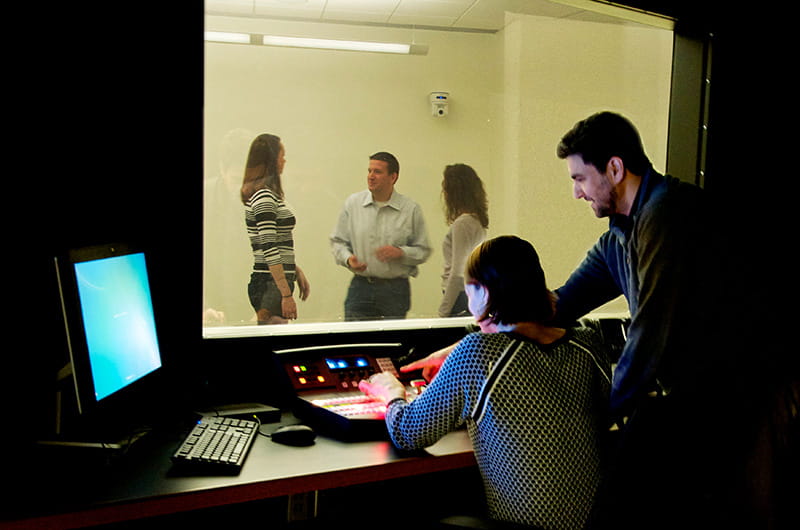LeBow Hall’s New Research Lab Has Eyes — and Controls — Everywhere

When you walk through the door next to the “Behavioral Lab” sign on the bottom level of Gerri C. LeBow Hall, you enter what looks like a normal reception area. You can take a seat in a waiting chair, near a desk where someone might greet you.
But if you tilt your head up, you may notice some things that seem out of place: a long white microphone and a black, dome-shaped camera fixture. That’s because there’s a lot more going on in the LeBow College of Business’ new behavioral lab than meets the eye.
The lab is wired for audio and video recording, sound playback and, in one room, even climate control, allowing researchers from LeBow or elsewhere at Drexel to study how people act and react — all from a control room filled with screens, buttons and knobs. And all the while, their research subjects see what looks like a normal waiting area, conference room or office.
This is the new home for research that once would have taken place in a simple classroom or office, and it opens up a world of possibilities, said Raj Suri, a LeBow professor of marketing.
“We’ve moved from a table, chair and pencil only to something that is up to your imagination now,” Suri said.
The centerpiece of the lab is a large studio room. It will soon be equipped with modular furniture to allow it to shift into private cubicles, an open space for people to meet and interact or whatever else a researcher can imagine.
“We can’t really decide ahead of time how research needs to be done,” Suri said. “Different people do research in different ways.”
The room contains five different cameras mounted on the walls, plus a one-way mirror through which researchers can watch from the lab’s control room, unseen by their subjects.
Suri said this will be invaluable to him and other researchers who study how people react to certain messages or stimuli. Instead of relying on surveys or written responses where people may or may not convey the truth about their reaction, researchers can watch their body language for clues: a lean, a slouch or a smile.
“That won’t get captured on paper,” Suri said. Plus, a researcher can go back and observe each individual subject on tape, rather than trying to watch the whole room at once.
An experimenter can also pipe sound into the studio room or the other rooms in the lab — and any subjects who happen to be in another room won’t hear a thing, thanks to sound insulation. If they wish, researchers can even control the temperature in the large studio room. Some research has found that people feel warmer, more positive feelings as temperatures go higher, Suri explained, so researchers might test how temperature might affect business transactions. If you’re courting a new client, is it better to meet in Philadelphia during the winter or in Florida?
Outside of the main studio room, a smaller conference room with chairs arranged around a table allows for a different experimental environment. It, too, is monitored by cameras and a one-way mirror.
Even the lab’s reception area can be used as part of experiments. If you want to study how people react when they have to wait excessively long for an appointment, you can watch and listen from the control room as they squirm and groan. Meanwhile, two “hidden” exits in the back of the lab allow experimenters, or subjects, to slip in and out without being seen by the people being studied, protecting against contamination that could invalidate results.
The lab will be open for use by any Drexel researcher, Suri said, and perhaps even outside groups and businesses. Research should begin in the lab sometime this month, said Al Riess, LeBow’s director of technology. And researchers are already making plans for how they could use it.
“The buzz is really good around here,” Riess said.
In This Article
Drexel News is produced by
University Marketing and Communications.

